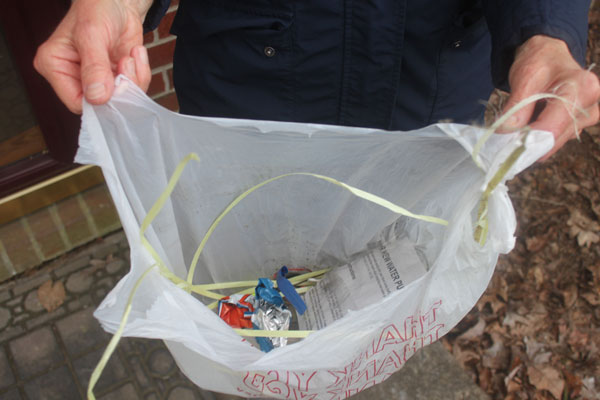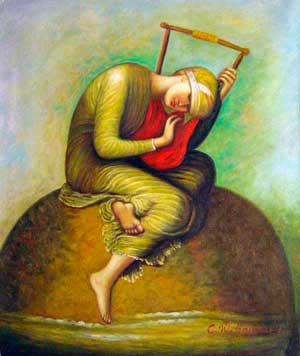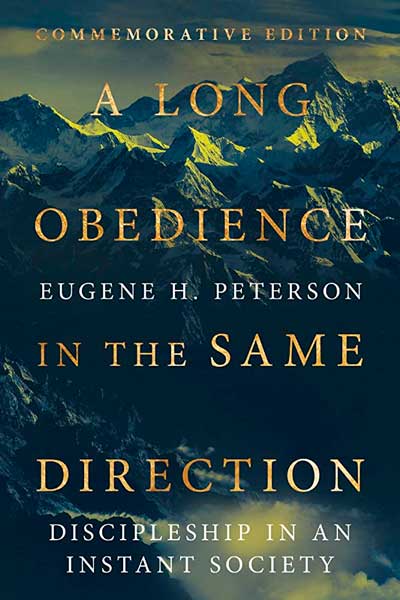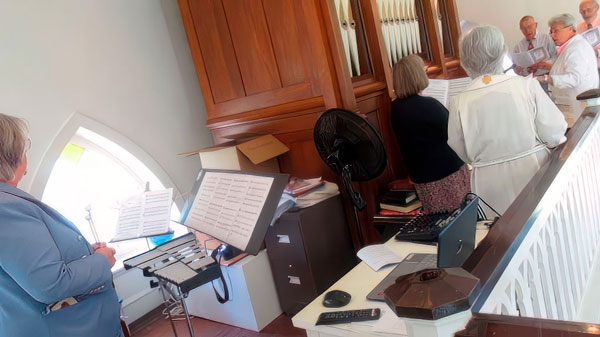I.Theme – "Peace Be With You"

"Incredulity of Thomas" – Duccio, di Buoninsegna (1308-1311)
The lectionary readings are here or individually:
First Reading – Acts 2:14a,22-32
Psalm – Psalm 16 Page 599, BCP
Epistle –1 Peter 1:3-9
Gospel – John 20:19-31
Jesus came back from the realm of the dead after only three days. He left the tomb behind, empty. The Apostles are still in their tomb, their emotional tomb, behind the locked doors of the house, after eight days. Theirs is a fear of the Jewish leaders who opposed Jesus and thus have no peace. Would they come after them? (Jn 15:18, 19). Would be accused of having stolen his body in some resurrection scam? The reality of Jesus execution has just hit them. Jesus comes back and shows them his wounds. The fear appears real!
Jesus visits them and twice says “Peace be with you.” Then he says it a third time a week later. Eventually they do unlock the doors and know that they are sent. There is the Gospel story this week of the Apostle Thomas ("Doubting Thomas") who wanted physical proof of Christ’s wounds before he would believe.
Alyce McKenzie writes that "peace be with you" was not just written in the New Testament by quoting the Psalms. "Peace is God’s gift of inner serenity to those who place their trust in God (Ps 4:8; Is 26:3, 12). Peace is both the goal (Ps 34:14) and the reward of righteousness (Is 32:17). Its presence will be a sign of God’s reign (Ps 85:10). Peace results when one loves and follows God’s law (Ps 119:165."
"This isn’t the first time Jesus has uttered this greeting. "Peace be with you," is the fulfillment of a promise Jesus made to his disciples in chapter 14 of John’s Gospel (Jn 14:18-28). The disciples were afraid that they would be "orphaned" (14:18). Jesus assured them that the Father, in his name, would send the Holy Spirit to both "teach and remind" them of Jesus’ message (14:26). He then promises them peace."
Their subsequent lives were not free of conflict, not even from conflict among themselves. He doesn’t give them a traditional peace -It is rather an inner calm in the midst of strife. Peace is calmly living on the edge, betwixt and between the ups and downs of life with Jesus walking by our side. As Alyce McKenzie writes "It is a statement of fact, of present reality." The emphasis is that Jesus lives in all of us with the resurrection in our difficult circumstances.
Jesus called us not for a quiet, leisurely life, but for an active mission that faces challenges, problems, and various trials. He gives us first of all His Peace to carry out the mission. A true peace over and against fear, and doubt. It is a mission to preach the good news of the Kingdom
He gives us His strength, His power, the Holy Spirit. The mission can be accomplished only through His Spirit. Jesus knew very well Thomas will not be able to fulfil the calling on his own, so He came back for him, to empower him also as He empowered the other disciples. So what is our mission ?
Rowan Williams, the former Archbishop writes about this mission – forgiveness. "The resurrection was an experience of forgiveness. The disciples had all abandoned Jesus, becoming complicit with his murderers. The fact that the resurrection was happening to them was an experience of forgiveness for them. " So he gives them another chance to them extend forgiveness into the world. Jesus demonstrated it by calling Saul (Paul) even though he was guilty of killing some of his followers.
II. Summary
First Reading – Acts 2:14a,22-32
This selected passage is part of Peter’s sermon at Pentecost; it is his eye witness testimony to the fact of the resurrection (v. 32). It was a powerful, Spirit filled sermon winning three thousand new converts! It is centered on Scripture (Peter quotes from Psalm 16), and on the person of Jesus Christ, and on the fact of the resurrection! Peter brought into contrast all that was known about Jesus of Nazareth the man (v. 22) and all that Scripture, in this case Ps. 16 testified about Him, in conclusion he proclaimed that the two together pointed at the resurrection, of which he and the other apostles were all witnesses!
Luke has described the coming of the Holy Spirit, a divine intervention in the world, as best he can in human terms: it was “like the rush of a violent wind” (v. 2) and “divided tongues, as of fire” (v. 3). Now Peter, on behalf of the other “eleven” (v. 14) apostles (Matthias has been chosen to replace Judas) has begun interpreting the event to them, “devout Jews from every nation” (v. 5). He has recalled God’s prophecy made through Joel (vv. 17-21): that “in the last days” there will be cosmic signs (including “fire”), then “I [God] will pour out my Spirit”, and then people will “prophesy” (probably enthusiastically share the faith) and salvation will be offered to all “who [call] … on the name of the Lord”. The “last days” are the time of the Church (1:6-8).
Having demonstrated from Joel that the end times are at hand, and therefore salvation is also at hand, Peter now demonstrates how we have access to salvation. First he shows that Jesus is the Messiah, from Psalm 16 (the quotation in vv. 25-28). Jesus, “a man attested … by God with deeds of power” (v. 22) was turned over by Jews to the Romans to be executed – as part of God’s plan for saving humankind. But God did not “abandon” (v. 27) him (permanently) to death. In the resurrection, Peter sees fulfilment of a prophecy of David that “your Holy One” would not experience “corruption” (or death). David was not speaking about himself because we can see “his tomb” (v. 29) today! So he must have been speaking of Jesus, who was raised from the dead (v. 32). Therefore, Jesus the Messiah gives access to salvation, and the way to be saved is to repent, and be baptized in his name (v. 38). Peter’s sermon is the crux of the message of Acts: the Spirit has been poured out to give power to God’s people; the end times are here; the Messiah has appeared; and a message of salvation must be preached so that those who hear may receive new life in Christ.
Psalm – Psalm 16
This is a Psalm of David, his praise of the faithfulness and the might of God. David is still a refugee, but he already has been promised the kingdom, even though in his present circumstances it seems to be in the distant future, if at all, but David takes God’s word as good and as real as if he would sit on the throne already.
David’s heart is glad, and he is rejoicing in praise, and rests in security even as he is on the run, for he focuses with the whole of his being upon God, who is his only good thing. David is assured that the Lord will not abandon him even in the grave! He set the Lord always before him, as soldier looks at his officer, musician at the conductor, sailor at the captain, so does the believer set the risen Lord before himself in all circumstances
Vv. 1-2 summarizes the psalm. The speaker probably takes refuge in worship in the Temple; he sees God as supreme good (v. 2). He takes the members of the faithful community, “the holy ones” (v. 3) as models for living; he will not worship with those who choose pagan gods – and not even associate with them (v. 4). His fate and his future (“portion and … cup”, v. 5) are in God’s hands. The author compares his devotion to that of a Levite. For other tribes, there were “boundary lines” (v. 6) between tribal territories in Israel, but Levites received no land; the psalmist’s “chosen portion” (v. 5) is God himself. God gives him “counsel” (v. 7) and deep understanding (“heart”). God teaches him his ways. Because God supports him, he will not stumble (“be moved”, v. 8) in following godly ways. V. 10 is unclear: it may refer to immortality or just to living a full lifetime. “Forevermore” (v. 11) may be meant literally but is more likely to mean throughout the rest of my life.
Epistle – 1 Peter 1:3-9
Peter is overflowing with joy and praise! His letter is a letter of hope. He who denied Jesus, lost all hope when Jesus was crucified. But on Easter morning he ran to the empty tomb, his hope was awakened; and later at the Sea of Galilee he jumped into the water and swam ashore to meet his risen Master before anyone else! He has been given new birth into a living hope through the resurrection of Christ! It was a life changing experience to him, as it should be to all of us! So Peter is looking ahead, forward towards that inheritance that now he has through Christ
Peter has addressed this letter to those “chosen and destined” (v. 2) by the Father and “sanctified” by the Holy Spirit in order “to be obedient to Jesus Christ” and to share in the forgiveness available through Christ’s sacrificial death (v. 2). (“Blessed be …”, v. 3, is a traditional Jewish prayer form.) The Father, in his mercy, has caused us to be born again (“new birth”, baptism) into a hope which is very much alive, “through the resurrection of Jesus Christ”. Our rebirth is also into “an inheritance” (v. 4): in the Old Testament, the inheritance was principally Palestine, but for the Church, it is heavenly. Palestine was lost in war, but our inheritance is “imperishable”, indestructible, free from sin (“undefiled”) and never lost. We, through our trust in God (“faith”, v. 5) are guarded by God’s power – for “salvation” – already accomplished but to be shown to all at the end of time (“last time”). In all of this (v. 6), the readers rejoice even if they have had to suffer “trials” (ostracism or persecution). These verify their faithfulness to God – as the purity of gold is tested by heating it. Such fidelity will be rewarded when Christ comes (to judge) at the end of time (v. 7). Their faith is such that they love him, believe in him and rejoice, even though they (unlike Peter) have never seen him (v. 8). Why? Because they are aware that they are being saved now – this being a logical and temporal goal of trust in God.
Key quote "Although you have not seen him, you love him; and even though you do not see him now, you believe in him and rejoice with an indescribable and glorious joy, for you are receiving the outcome of your faith, the salvation of your souls."
Gospel – John 20:19-31
Early on Easter Day, Mary Magdalene has discovered that Jesus’ body is missing from the tomb; the door is open, so it looks as though someone has stolen it (v. 1). She has seen a man standing near the tomb. When he speaks to her, she recognizes him as Jesus. She has told the disciples: “I have seen the Lord” (v. 18).
Later the same day, Jesus joins the disciples, gathered behind locked doors. He shows them that he is the one who was crucified (v. 20). Jesus confers on “the disciples” (not including Thomas, but perhaps a group larger than the ten) “peace” (vv. 19, 21) and “the Holy Spirit” (v. 22). As God “breathed” life into Adam, the proto-human, so Jesus now breathes the new, spiritual, life of recreated humanity into his followers. Aided by the Spirit, they continue Jesus’ judicial role in the world, forgiving the sins of the faithful and holding others blameworthy (“retain”, v. 23) for their actions. Thomas is expected to believe without having seen, but he demands: show me the evidence! (v. 25) The next Sunday, the community gathers again (v. 26). Upon seeing, Thomas makes the most complete affirmation of faith of anyone in the gospel (v. 29). Henceforth the faith of all Christians in all ages will rest on the testimony of the first believers. Vv. 30-31 tell us John’s purpose in writing the book. His eyewitness account is intended to help us, who were not witnesses of Jesus’ life, death, resurrection and ascension to “come to believe” and thus “have life in his name”, eternal life.
This is the story of "Doubting Thomas." David Lose writing this week provides 3 reason why this is an unfortunate title:
"First, Thomas is not anywhere in John’s Gospel — the only gospel where he has his own scene, lines, or characterization — described as "the doubter." Rather, he is "the Twin," a name most of us have long forgotten. Further, when Jesus has declared his intention to return to Judea — and the other disciples try to dissuade him because they know it will mean his death — it is Thomas to urges the others to follow Jesus "so that we may die with him" (11:16). Thomas is not so much a doubter as he is a realist, and a few days earlier he’d encountered reality like never before as he saw his friend and lord nailed to the cross and die. Now, when his friends tell him that they’ve seen the Lord, he reacts with a realist’s skepticism, kind of like a terminally ill patient who has accepted his fate might react to news of a new "miracle cure."
"Second, did you ever notice that what Thomas asked for was exactly what all the other disciples got? When Jesus appeared to the other disciples he showed them his hands and his side and only then, John records, did the disciples rejoice "because they saw the Lord" (20:20). One conclusion we might draw is that, despite his bad rap, Thomas is no worse than the other disciples. More importantly, however, perhaps we’ve actually misunderstood the nature of faith altogether, assuming that the "more" faith we have the fewer questions we’ll ask
"Third, Jesus’ words at the end of this scene aren’t, I think, really about Thomas. After all, who are "those who have believed and not seen"? Well, it starts with the members of the early Christian community to whom John writes…and continues to include all of us. That’s right: Jesus isn’t so much rebuking Thomas as he is blessing us. "Blessed are those who have not seen and yet have come to believe."
Lose concludes that doubt is an essential part of faith. "Once he (Thomas) has encountered Jesus, his faith is as realistic as was his skepticism, as he doesn’t merely believe but also makes the chief confession in John’s gospel, acclaiming Jesus not only as "my Lord" — the title reserved for Caesar in the first century — but also "my God," the highest praise of Jesus made in the New Testament and an echo of the opening line of John’s Gospel.
Thomas like all of us have difficulty believing God’s messiah would be crucified and the unheard of plan of salvation from this violence ?
The passage reflects the historical times it was written. At the time of this Gospel we know of a drift toward gnosticism, or docetism, the tendency to say that Jesus just seemed to be human. This emphasis on the hands and side is a way of saying that the crucifixion was a real death of a real human being.
III. Articles for this week in WorkingPreacher:
First Reading – Acts 2:14a, 22-32
Psalm – Psalm 16
Epistle – 1 Peter 1:3-9
Gospel – John 20:19-31





 I like Eugene Peterson’s explanation of repentance in his book, Long Obedience in the Same Direction.
I like Eugene Peterson’s explanation of repentance in his book, Long Obedience in the Same Direction.



